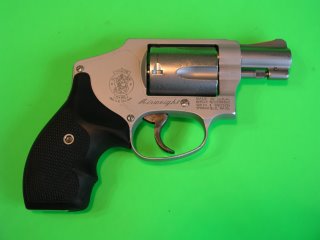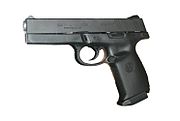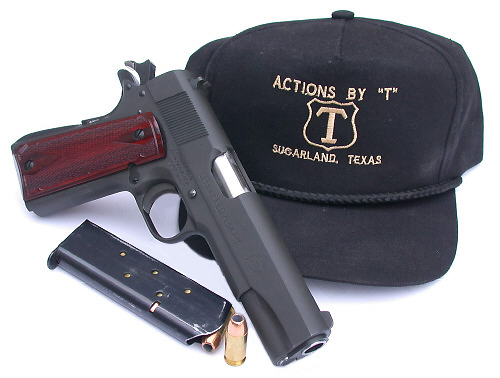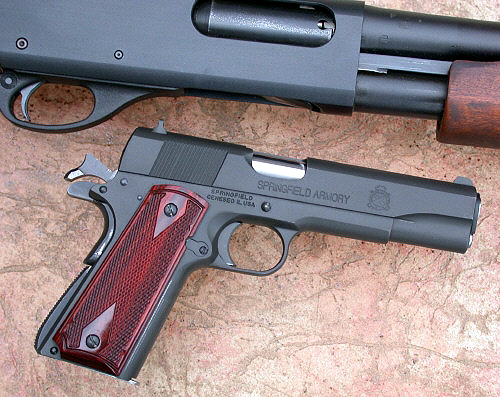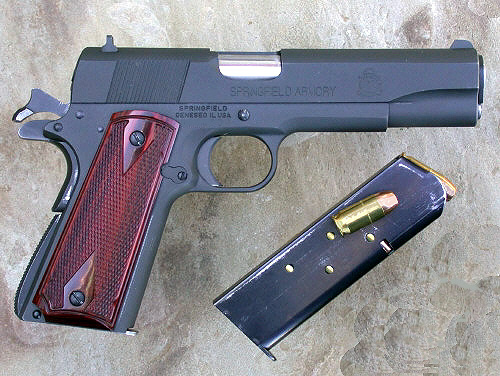TUES. - Jan. 30, 2007
I do not recommend the purchase of any SOG knife, this is my personal opinion only as I have encountered hostility and misery with their warranty dept. The woman there is very nasty and there are far better choices in the purchase of a knife such as COLD STEEL and BENCHMADE etc, etc, etc. There is no one to talk to that seems to want to help some one like me that runs into defective SOG knives. AT THIS TIME I HONESTLY FEEL THAT THE PURCHASE OF A SOG PRODUCT IS A TOTAL WASTE OF YOUR HARD EARNED MONEY. THERE ARE SO MANY BETTER KNIVES TO CHOOSE FROM MADE BY OTHER COMPANIES.
Teddy
...................................................................................
PROJECT STREET GUN #6
We are now accepting names of people that want to be in our next PROJECT STREET GUN CLASS WHICH IS NUMBER SIX. This is not a formal class, we will provide everything you need to do the work your self at your home and at your convenience. I would like to maintain about 15 people for this new project.
Please go to my website www.actionsbyt.com
and email me and we can discuss it in detail. I prefer to use the basic SA mil-spec 1911-a1 parkerized pistol. I do not want to use the stainless steel version.
I will accomodate some people if they have a new Colt, whether it be a series 70 or an 80. We can discuss it all. I have separate DVD's one for the series 70 and another one for the series 80.
Thankyou,
www.actionsbyt.com
281 565 6977
...........................................
Smith & Wesson
DISCLAIMER : I DO NOT RECOMMEND THE CURRENT PRODUCTION PRODUCTS OF SMITH AND WESSON HANDGUNS. THIS IS MY PERSONAL OPINION ONLY WHICH IS BASED ON MANY YEARS OF HANDS ON EXPERIENCE. THEY SEEM TO BE VERY INTERESTED IN SELLING YOU CHEAP CHINESE KNIVES AND COFFEE MUGS AND CLOTHING. MY OPINION ONLY...
SEE PHOTOS AT THE VERY BOTTOM - FEB. 1, 2006
.......................................................................................................................
| Smith & Wesson Holding Corp. | |
 | |
| Type | Public NYSE: SWHC |
|---|---|
| Founded | 1852 |
| Founder | Horace Smith, Daniel B. Wesson |
| Headquarters | Springfield, Massachusetts, United States of America |
| Key people | Michael F. Golden (CEO), John A. Kelly (CFO), |
| Industry | Aerospace/Defense Products & Services |
| Products | Firearms and law enforcement goods |
| Revenue | US$190,770,000 (2006) |
| Operating income | US$12,600,000 (2006) |
| Employees | 832 (2006) |
| Subsidiaries | Thompson/Center |
| Website | Smith-Wesson.com |
Smith & Wesson NASDAQ: SWHC are the largest manufacturers of handguns in the United States. Their corporate headquarters are in Springfield, Massachusetts. Smith & Wesson have a reputation for the many types of ammunition they have introduced over the years and for their revolver expertise.
Contents |
History of Smith & Wesson
Beginning
In 1852 partners Horace Smith and Daniel B. Wesson formed a company to produce a lever-action pistol nicknamed "The Volcanic". The company became known as the "Volcanic Repeating Arms Company", and due to financial difficulties came into the majority ownership of investor Oliver Winchester.
In 1856 the partners left the Volcanic Company to begin a new company and to manufacture a newly-designed revolver-and-cartridge combination. The timing of the founding of this new company proved quite opportune for the partners, as the onset of the American Civil War five years later produced a great demand for Smith & Wesson's products.
In 1964 the company passed from Wesson family control, and subsequently a number of conglomerates took control of it.
From 1987 to 2001 Tomkins PLC, a British company, owned Smith & Wesson.
The Agreement of 2000
In March 2000 Smith & Wesson signed an agreement with the Clinton administration in order to avoid lawsuits. The company agreed to a number of safety and design standards, as well as limits on the sale and distribution of their products. Gun clubs and gun rights groups responded to this agreement almost instantly by initiating large-scale boycotts of Smith & Wesson by refusing to buy their new products and flooding the firearms market with used S&W guns, cutting into their market share. [1][2][3]
Acquisition by Saf-T-Hammer
On May 11, 2001, Saf-T-Hammer Corporation acquired Smith & Wesson Corp. from Tomkins PLC for US$15 million, a fraction of the US$112 million originally paid by Tomkins. Saf-T-Hammer also assumed US$30 million in debt, bringing the total purchase price to US$45 million. [4] [5] Saf-T-Hammer, a manufacturer of gun locks and other firearms safety products, purchased S&W with the intention of incorporating its line of security products into all Smith & Wesson firearms in compliance with the 2000 Clinton administration agreement.
The acquisition of Smith & Wesson was chiefly brokered by Saf-T-Hammer President Bob Scott, who left S&W in 1999 due to disagreement with Tomkins’ policies. After the purchase Scott became the President of Smith & Wesson to guide the 157-year-old company back to its former standing in the market.
On February 15, 2002 the name of the newly formed entity was changed to Smith & Wesson Holding Corporation.
Corporate governance
As of 2005 Smith & Wesson have the following members on its board of directors: Jeffrey Buchanan, John Furman, Michael F. Golden, Colton Melby, James Minder, Barry Monheit, Mitchell Saltz, Robert L. Scott, and Marie Wadecki.
Ammunition types introduced by Smith & Wesson
- .22 Short — the popular .22 Long Rifle, based on the .22 Short actually developed by the J. Stevens Arms & Tool Co.
- .32 S&W — sometimes called .32 Short
- .32 S&W Gallery
- .32 S&W Long — sometimes called .32 New Colt Police, or 32-44 Target
- .35 S&W Automatic
- .38 S&W — sometimes called .38 Colt New Police
- .38 S&W Special
- .357 S&W Magnum
- .40 S&W
- .41 Remington Magnum — While Remington developed the ammunition, S&W made the first revolvers to chamber this cartridge.
- .44 S&W American
- .44 S&W Russian
- .44 S&W Special
- .44 Remington Magnum (see note at .41 Remington Magnum)
- .45 S&W Schofield
- .460 S&W Magnum
- .500 S&W Magnum
Famous S&W revolvers
- S&W Model 3 — first automatic ejection of used ammunition
- J-Frame (small) Models
- S&W Model 60 — first stainless .38 Special
- S&W Model 340PD — first revolver made of scandium alloy, very light, possibly the final evolution of the classic J-frame Chief's Special introduced over 60 years earlier
- S&W Ladysmith
- K-Frame (medium) Models
- S&W Model 10 — first .38 Special, evolved from the famous Smith & Wesson M&P
- S&W Model 12
- S&W Model 13
- S&W Model 14
- S&W Model 15
- S&W Model 16
- S&W Model 17
- S&W Model 18
- S&W Model 19 — first lightweight .357 Magnum, built at the request of Bill Jordan
- L-Frame (medium-large) Models
- Model 586 — blued steel
- S&W Model 686 — stainless steel
- N-Frame (large) Models
- S&W Model 25 — both .45 ACP and .45 LC
- Model 27 — first .357 Magnum; usually a custom or limited-run revolver, with a deep blue lustre
- Model 28 — "Highway Patrolman" .357 Magnum; fewer frills than the Model 27, same performance; marketed to police due to its reduced price and equal performance.
- Model 29 — first .44 Magnum, made famous by its appearance in the film Dirty Harry
- S&W Model 1917 — first revolver chambered for .45 ACP
- S&W Model 66 — Combat Magnum; the definitive S&W revolver when police officers still used wheel guns
- S&W Model 624
- Model 625 — used by Jerry Miculek to set the world record for 12 rounds (with one reload) on target in 2.99 seconds
- S&W Model 627 — replacement for Model 27
- S&W Model 629
- X-Frame
Famous S&W semi-automatic pistols
Classic semi-automatic pistols
- S&W Model 39 — first U.S.-designed double-action pistol in 9 mm Luger Parabellum
- S&W Model 41 and later variants — target pistols chambered in .22 LR
- S&W Model 52 and later, 52-1 and 52-2 — target pistols chambered in .38 Special, rare for auto-loading pistols
- S&W Model 3913
- S&W Model 4506
- S&W Model 469
- S&W Model 59 — first high-capacity double-action pistol in 9 mm Luger Parabellum
- S&W Model 5906
- S&W Model 910
- S&W Model 1006 — stainless steel 10mm auto
- S&W Model 4006
Sigma series
Smith & Wesson introduced the Sigma series of recoil-operated, locked-breech semi-auto pistols in 1994 with the Sigma 40, followed by the Sigma 9. Sigma pistols bore so much similarity to Glock's that users could reportedly interchange many parts between Glock and Sigma models. The similarities were so great that many pundits referred to the Sigma series as 'Swocks', a playful contraction of S&W and Glock. As a result, Glock initiated a patent infringement lawsuit against Smith & Wesson, which paid an undisclosed sum (the amount of three million dollars has been theorized) to Glock for infringement of their patents. S&W thereupon received the rights to continue the production of Sigma line, but they were forced to redesign the pistol's trigger mechanism so that it did not infringe upon Glock's patents.
The gun frame is manufactured from polymer, while the slide and barrel use either stainless steel or carbon steel. In 1999 S&W updated the Sigma by shortening the barrel (from 4-1/2 to 4 inches) and added an integral accessory rail for lights and laser target designators.
- Sigma 9 — uses the 9 mm Luger Parabellum ammunition
- Sigma 40 — uses the .40 S&W ammunition
- Sigma 380 — uses the .380 ACP ammunition
SW99 Series
S&W also reached an agreement with Walther to produce variations of the P99 line of pistols. Branded as the SW99, the pistol is available in several calibers, including 9mm, .40 S&W, and .45 ACP, and in both full size and compact variations. Under the terms of the agreement, Walther produced the receivers, and Smith and Wesson produced the slide and barrel. The pistol has several cosmetic differences from the original Walther design, and strongly resembles a hybrid between the P99 and the Sigma series mentioned above finale.
M&P Series
Pistols
In 2005, Smith & Wesson debuted a new polymer-frame pistol intended for the law enforcement market. Dubbed the M&P (standing for Military and Police), its name was meant to evoke S&W's history as the firearm of choice for law enforcement agencies through its previous lineup of M&P revolvers. Though similar in appearance to the still-produced Sigma lineup, the M&P is a new design. Many of the ergonomic study elements that had been incorporated into the Sigma and the SW99 were brought over to the M&P. The improved trigger weight and feel, and unique takedown method (not requiring a dry pull of the trigger) were meant to set the M&P apart from both the Sigma and the popular Glock pistols.
It is available in 9x19, .40 S&W, and .357 SIG. A .45 ACP model will be released in early 2007, after making its debut at the SHOT show. Compact version are available in 9x19, .40 S&W and .357 SIG.
Rifles
In January 2006 Smith & Wesson entered into the AR-15 market with its M&P15 series of rifles. Unveiled at SHOT Show 2006, the rifle debuted in two varieties; the M&P15 and the M&P15T. Both are basically the same rifle, chambered in 5.56 NATO, with the T model featuring folding sights and a four-sided accessories rail. At it's debut, the M&P15's suggested retail price was $1,200, while the M&P15T retailed for $1,700. [6]
Shotguns
Smith & Wesson produced the Model 916,916T,916A 12 gauge shotguns which were plagued by poor quality control and had cascading minor issues in the field, prompting them to move on to the model 1000 and 3000 shotguns. Smith & Wesson exited the shotgun market in the early 70's to return to their "core" market of handguns.
In November 2006 S&W announced that it would reenter the shotgun market with two new lines of shotguns, the Elite series and the 1000 series, to be unveiled at the 2007 SHOT Show. Along with the new shotguns S&W debuted the Heirloom Warranty program, a first of its kind in the firearms industry. The warranty provides both the original buyer and the buyer's chosen heir with a lifetime warranty on all Elite Series shotguns. [7]
SW1911 Series
In 2003, Smith & Wesson introduced their variation of the classic M1911 .45 ACP semi-automatic handgun, the SW1911. This firearm retains the M1911's well known dimensions, operation, and feel, while adding a variety of modern touches. Updates to the design include serration at the front of the slide for easier operation and disassembly, a high "beaver-tail" grip safety, external extractor, lighter weight hammer, and trigger, as well as updated internal safeties to prevent misfires if dropped. S&W 1911s are available with black finished carbon steel slides and frames or bead blasted stainless slides and frames. They are also available with aluminum frames alloyed with Scandium in either natural or black finishes. These updates have resulted in a firearm that is true to the M1911 design, with additions that would normally be considered "custom", with a price similar to entry-level M1911 designs from other manufacturers.
Internal Locking Mechanism
All Smith & Wesson firearms have been equipped with an internal locking mechanism since the acquisition by Saf-T-Hammer. The mechanism itself is a relatively unobtrusive lock which, when activated with a special key, renders the firearm inoperable. While the lock could simply not be used at all, some gun owners refuse to buy "post-lock" guns, fearing the extra part might fail when they need it most. Smith & Wesson have repeatedly stated that the locking mechanism does not affect reliability. More, however, dislike it as it reeks of government interference, and is symbolic one of the country's oldest firearms makers "giving in".
Police bicycles
In addition to firearms, Smith & Wesson has also licensed its name to a line of bicycles designed by and for police. These bicycles have features such as higher handlebars and silent hubs. [8] [9]
Flashlights
Smith & Wesson Flashlights are also now available to the general public. They are designed and produced by PowerTech, Inc. in Collierville, Tennessee with Smith & Wesson's approval on every product.
Miscellaneous
Nineteenth century Japanese samurai and revolutionary Sakamoto Ryoma carried a Smith & Wesson revolver. [10]
In 2005, the History Channel released a documentary about Smith & Wesson titled "Tales of the Gun: Guns of Smith & Wesson". [11]
In November 2006, Smith & Wesson announced that it would begin manufacture of shotguns for the 2007 model season, a market it has not been a part of since the 1970s [12]
References
- ^ Gun Owners call for boycott
- ^ Action America News Story
- ^ VCDL.org News Story
- ^ Article on Sale of Smith & Wesson
- ^ Phoenix Business Journals on Smith & Wesson Sale
- ^ S&W press release on new M&P15 Rifles
- ^ S&W press release on new line of shotguns
- ^ S&W press release on new line of bicycles
- ^ S&W press release on Police Bicycles
- ^ Things Asian article on Sakamoto Ryoma
- ^ AETV Store
- ^ Nasdaq News Story
External links
- Smith & Wesson Firearms — American-made firearms and handguns
- Freepatriot — Detailed list of Smith and Wesson Revolvers
- The Snubnose Files, dedicated to the Snubnose Revolver
Categories: Companies listed on the New York Stock Exchange | Companies listed on NASDAQ | Articles with unsourced statements | Firearms manufacturers in the United States | Gun politics | Springfield, Massachusetts | American Civil War weapons | Massachusetts in the American Civil War
Smith & Wesson Revolvers

Smith & Wesson Model 64 Revolver

S&W 642 with cracked frame

